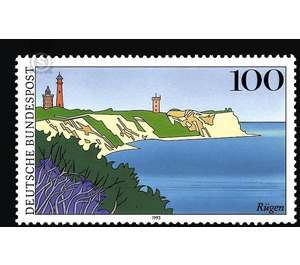Pictures from Germany (1) - Germany / Federal Republic of Germany 1993 - 100 Pfennig
Theme: Geology & Geography
| Country | Germany / Federal Republic of Germany |
| Issue Date | 1993 |
| Face Value | 100.00 |
| Color | multi-colored blue |
| Perforation | K 13 3/4: 14 |
| Printing Type | Multicolor offset printing |
| Stamp Type | Postage stamp |
| Item Type | Stamp |
| Chronological Issue Number | 1557 |
| Chronological Chapter | GER-BRD |
| SID | 238854 |
| In 49 Wishlists | |
White chalk cliffs, 600 km of coastline, fine-grained sandy beaches, quiet extensive beech forests, the harsh beauty of Cape Arkona: Germany's largest island has many charming faces. Großsteingräber prove that Rügen was populated more than 1,000 years ago and attracted merchants and sailors. Germanic and Slavic castle walls tell of a turbulent history. Only at the beginning of the 19th century did people seeking relaxation move to Rügen. Prince Malte von Putbus built the royal seat Putbus after Italian models. Even before the seaside resorts of Binz, Sellin, Baabe and Göhren gained their reputation on the southeast coast of Rügen, the high nobility met in a classicistic bathhouse near Lauterbach, in the Goor. Who has seen the frozen Bodden waters in January, the chalk coast in the dim light of a winter afternoon, who in the woods of the Granitz sees the white carpet of the flowering wood anemones or who experiences the colorful splendor of autumn on Rügen, collecting the migratory birds and their rest on the harvested fields, which has undoubtedly fallen in love with the "other" Rügen, the complaints beyond the seasonal turmoil. (Text: Tourism Association Rügen e.V., Ostseebad Sellin)


